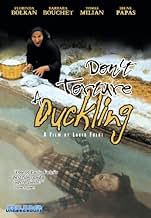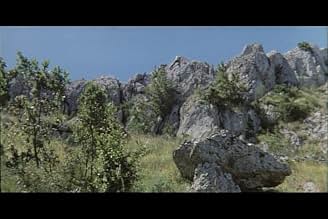IMDb RATING
7.0/10
12K
YOUR RATING
When a southern Italian town is rocked by a string of child murders, the police and two urban outcasts search for the culprit amid scapegoating within the superstitious community.When a southern Italian town is rocked by a string of child murders, the police and two urban outcasts search for the culprit amid scapegoating within the superstitious community.When a southern Italian town is rocked by a string of child murders, the police and two urban outcasts search for the culprit amid scapegoating within the superstitious community.
Georges Wilson
- Francesco
- (as George Wilson)
Virgilio Gazzolo
- Police Commissioner
- (as Virginio Gazzolo)
Fausta Avelli
- Malvina
- (uncredited)
Gianfranco Barra
- Impallomeni
- (uncredited)
John Bartha
- Policeman
- (uncredited)
Empedocle Buzzanca
- Interrogation Officer
- (uncredited)
Featured reviews
I really enjoyed this film although I have only had a chance to watch it once. It's a great Giallo IMO and just as enjoyable as Fulci's later films. The direction was perhaps a bit rough around the edges but on the whole I thought the film worked really well and the ending was great (a real cliff hanger!). I thought one scene was particularly disturbing when the locals beat the hell out of a poor women while the radio played in the background. The inappropriate music made the images even harder to swallow but also gave the scene an emotional punch uncommon in a Fulci movie. I also felt that the story worked coherently and that the twist at the end was great. Fulci obviously has a rather low opinion of rural Italy's inhabitants because in this film all the villagers are presented as simpletons prone to mass-hysteria who live by their own backward laws (illustrated by the remorseless killing of the women) and religious beliefs.
Set in and near a poor working class town in the mountains of rural Italy, it's a story of madness. The landscape may be quite picturesque, but there's madness herein, concealed behind the mask of a person who seems outwardly normal. This person kills little children.
In style and tone this film resembles Dario Argento's famous Italian giallos, those fascinating whodunit horror films, except that Argento's films are much better looking. Still, the visuals in Fulci's "Don't Torture A Duckling" are competent, with some interesting compositions and lighting. Lightning and thunder on a rainy night enhances suspense in one sequence wherein one of the "ducklings" is vulnerably alone.
In one sequence the gore is a bit overdone. But this is no slasher film. A legitimate theme undergirds the story. And that theme is that madness can take many unexpected forms, not just the obvious delusions of people who practice voodoo or black magic.
Plenty of red herrings render the puzzle solution difficult if the viewer doesn't assume an agenda on the part of the director. Don't dismiss someone who might not seem to be a suspect. The twist near the end provides good misdirection. However, in one scene midway through, a line of dialogue could have been added to clarify the relationship between two characters, one of whom is the murderer. The film's finale takes place on a beautiful mountaintop with the wind whistling in the background. We see flashbacks to clues and get insights into the killer's mindset.
I don't care for the film's widescreen projection. But background music is effective, and ranges from jarringly creepy at the beginning to low-key jazz, to indigenous Italian songs. Acting is generally average, though in a couple of cases, it's a bit overdone.
Though not as visually brilliant as Argento's giallos, "Don't Torture A Duckling" nevertheless is a fine film, one that contains a thematic storyline and enough of a whodunit puzzle to interest most viewers who like thrillers and murder mysteries.
In style and tone this film resembles Dario Argento's famous Italian giallos, those fascinating whodunit horror films, except that Argento's films are much better looking. Still, the visuals in Fulci's "Don't Torture A Duckling" are competent, with some interesting compositions and lighting. Lightning and thunder on a rainy night enhances suspense in one sequence wherein one of the "ducklings" is vulnerably alone.
In one sequence the gore is a bit overdone. But this is no slasher film. A legitimate theme undergirds the story. And that theme is that madness can take many unexpected forms, not just the obvious delusions of people who practice voodoo or black magic.
Plenty of red herrings render the puzzle solution difficult if the viewer doesn't assume an agenda on the part of the director. Don't dismiss someone who might not seem to be a suspect. The twist near the end provides good misdirection. However, in one scene midway through, a line of dialogue could have been added to clarify the relationship between two characters, one of whom is the murderer. The film's finale takes place on a beautiful mountaintop with the wind whistling in the background. We see flashbacks to clues and get insights into the killer's mindset.
I don't care for the film's widescreen projection. But background music is effective, and ranges from jarringly creepy at the beginning to low-key jazz, to indigenous Italian songs. Acting is generally average, though in a couple of cases, it's a bit overdone.
Though not as visually brilliant as Argento's giallos, "Don't Torture A Duckling" nevertheless is a fine film, one that contains a thematic storyline and enough of a whodunit puzzle to interest most viewers who like thrillers and murder mysteries.
Overall, this is a really good movie (pretty close to great). I actually think that when I revisit this film (as is bound to happen) I'll enjoy it more the next time through. As far as a giallo film, this movie wasn't nearly as much fun as any of Argento's entries, but it did try to do some things that I found innovative and compelling. For my first Fulci film, I was rather impressed, though I can almost say for certain he won't be replacing Argento as one of my favorite horror directors. This movie is a twisty entry into a genre I love, and it's one that I've already recommended to a few people. For our full review of Don't Torture a Duckling visit True Myth Media!
Sporting a title seemingly more suitable for a Looney Tunes featurette than a grisly giallo, "Don't Torture a Duckling" (1972) is nonetheless a Grade A thriller from horror maestro Lucio Fulci. In this one, someone has been strangling the preteen boys in a rural, southern Italian village and, typical for these gialli, there are many suspects. There's Barbara Bouchet (Patrizia), looking more scrumptiolicious than you've ever seen her, a rich girl hiding out after a drug scandal; Florinda Bolkan (Martiara), the local epileptic voodoo woman; her witchcraft-practicing beau; Giuseppe, the local idiot; the sweet-faced priest; his dour mother; and on and on. The film features some unusually violent set pieces, including a chain whipping of one of the main characters in a graveyard (one of the most realistically bloody sequences that I've ever seen) and a nifty dukeout when the killer is ultimately revealed. The film's bursts of violence compensate for the fact that there are no real scares or suspense to speak of. Still, this giallo fascinates, with its unusual rural backdrop, unsettling child murders, oddball characters, and freaky score by Riz Ortolani. The film has been beautifully photographed in what I presume to be Monte Sant'Angelo, near the Adriatic in southern Italy (at least, that town's police force is thanked in the closing credits). And while subtitling would've made this fine-looking DVD work even better (the American slang doesn't convince in this rural Italian setting), Anchor Bay is to be thanked for another job well done. Oh...that title DOES eventually make perfect sense, too!
I didn't know what to expect when I rented this widescreen DVD. I knew it had a cult following but I had also seen a lot of the director's later works which although delightfully gory were also pretty much incoherent. DON'T TORTURE A DUCKLING actually had a linear storyline and a mystery that kept me guessing almost until the end. And after all was said and done, it was a genuinely unsettling and creepy experience. One major caveat: I would much rather have heard the original soundtrack and read English subtitles than the uneven dubbing found here.
Did you know
- TriviaLucio Fulci was arrested on child endangerment grounds due to the infamous scene where a fully nude Patrizia (Barbara Bouchet) flirts with the underage Michele (Marcello Tamborra). The charges were dropped when Fulci explained that the actors' close-ups were filmed separately, and that the shot of Michele walking towards Patrizia with a pitcher and glass of orange juice was achieved by having an adult dwarf actor, Domenico Semeraro, stand in for Tamborra (if you look carefully, you will notice how different Semeraro's facial structure is from Tamborra's). Tamborra joked many years later that he wished he could have filmed that scene. But his parents wouldn't even let him see the film until he turned 15.
- GoofsIn the early scene in which the boy brings a beverage to the nude Ms. Bouchet, the liquid in the glass and pitcher are a deep orange. But when she holds the glass and in the final shot of the pitcher, the contents have changed to a pale, almost clear color.
- Alternate versionsThe Anchor Bay release is the complete, uncut version of the film.
- ConnectionsFeatured in Innocence Lost (2015)
- SoundtracksQuei giorni insieme a te
Lyrics by Jaja Fiastri (uncredited)
Music by Riz Ortolani (uncredited)
Performed by Ornella Vanoni
- How long is Don't Torture a Duckling?Powered by Alexa
Details
- Release date
- Country of origin
- Language
- Also known as
- Fureur meurtrière
- Filming locations
- Monte Sant'Angelo, Foggia, Apulia, Italy(the town of Accendura setting)
- Production company
- See more company credits at IMDbPro
Contribute to this page
Suggest an edit or add missing content

Top Gap
By what name was La Longue Nuit de l'exorcisme (1972) officially released in India in English?
Answer
































